(VOVWORLD) - 100 kilometers from Ho Chi Minh City, Ta Thiet military base relic site in Binh Phuoc province once served as the headquarters for the Liberation Army of South Vietnam. The base was a strategic logistics reserve and the venue for the establishment of the Ho Chi Minh Campaign Command, which led the Vietnamese people to victories and national reunification in April, 1975. The Ta Thiet relic is now incorporated with eco-tourism stretching 3,200 hectares of forest and covering victory monuments, temples, traditional cottages for military officials, an underground meeting room where the Ho Chi Minh Campaign Command was assigned, and guest houses with100-bed capacity.
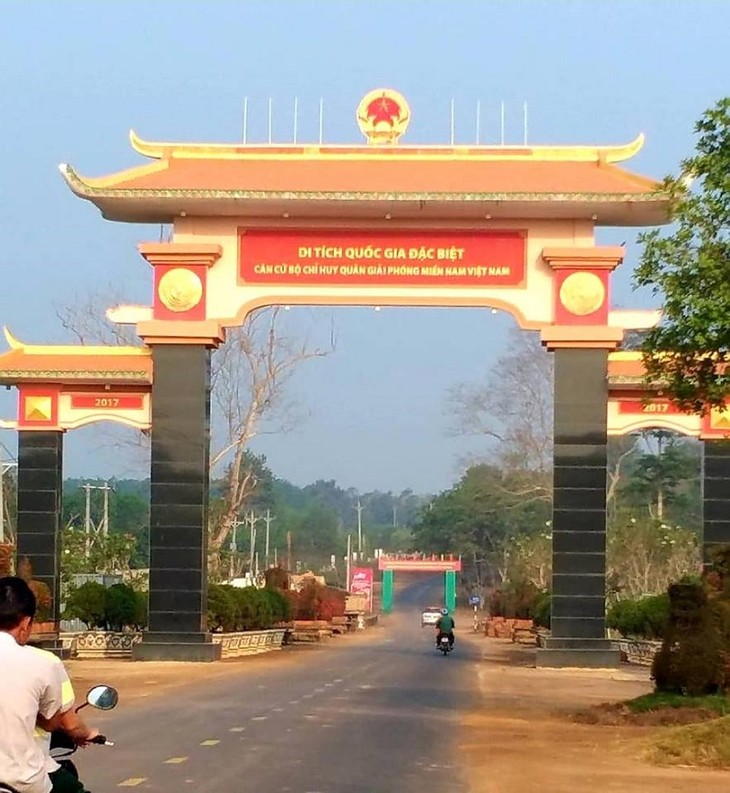 Ta Thiet's entrance gate. (Photo: dangcongsan.vn) Ta Thiet's entrance gate. (Photo: dangcongsan.vn) |
A narrow cement path leads visitors from the entrance gate to the central area, crossing through the green rubber forest.
A flag monument has been inaugurated recently, making it possible for a bird’s-eye view of the whole area. Once you’ve entered the main reception house, electric car service is available to take you to different clusters of relics where you walk on foot deeper inside the forest to visit each place.
 Ta Thiet's flag monument. (Photo: binhphuoc.gov.vn) Ta Thiet's flag monument. (Photo: binhphuoc.gov.vn) |
The cars first take visitors to a square where a worshiping house is located. It was built after the war to pay tribute to President Ho Chi Minh and leaders of the Central Office for South Vietnam and the Liberation Army of South Vietnam, who shed blood and tears from 1960 to April 1975 when the north and south of Vietnam were reunified.
During the anti-US war, the Command of the Liberation Army of South Vietnam had to move its headquarters several times. Ta Thiet was the last and the largest, where the Ho Chi Minh Campaign Command made its call for the 1975 spring general offensive and uprising.
"Ta Thiet is located at the end of the Truong Son trail. Here, we gathered soldiers, food, weapons, and other necessities supplied by the north to the battle fields in the southeastern region," said tour guide Truong Thi Thuy about why Ta Thiet was chosen.
"Loc Ninh district in Binh Phuoc was liberated in April, 1972, the very first district in southern Vietnam to be liberated, and became the capital of the Provisional Revolutionary Government of the Republic of South Vietnam. With huge forest coverage and less extreme weather, the Ta Thiet area played as a surprise to the enemies," Thuy said.
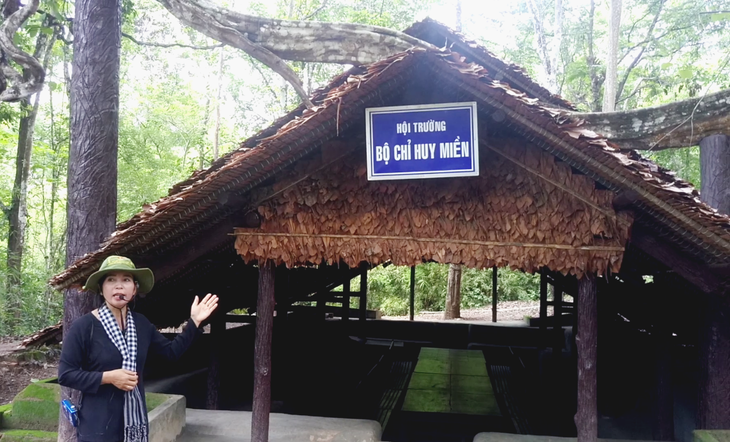 Tour guide Truong Thi Thuy introduces the meeting hall where the Ho Chi Minh Campaign Command was established. (Photo: binhphuoc.gov.vn) Tour guide Truong Thi Thuy introduces the meeting hall where the Ho Chi Minh Campaign Command was established. (Photo: binhphuoc.gov.vn) |
Revolutionary music from tour guide Thuy’s radio really fits the ambience while walking through the forest to several cottages the military leaders were once based in.
Thuy said that each time she plays the music in the forest, she is reminded of the soldiers marching through the Truong Son mountain range. Whether a living space or a meeting room, all cottages have the same structure: dig a small square of land, erect four bamboo pillars, and tile a leaf roof. They don’t have walls. Each cottage is big enough for a single bed, a working table, and a cabinet. You can visit as many cottages as you wish. The architecture is the same, just the officials who lived in them were different.
The cottages were built under the giant canopy of forest trees, each of which was big enough for several adults to clasp hands around. Their leaves, called “trung quan” by the soldiers, were used to create the roof. “Trung quan” means loyal to the leader. The local ethnic people also used these kinds of leaves to roof their houses. The leaves are called “khanh ma” by the Khmer or “cho don” of the S’Tieng local ethnic people.
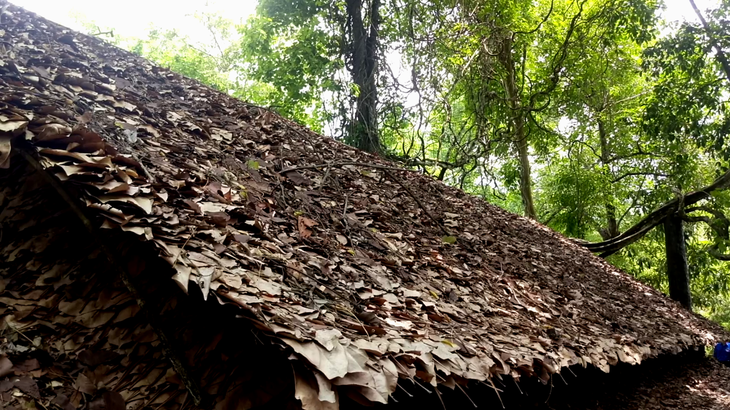 "Trung quan" leaves are used to tile Ta Thiet cottages’ roofs. (Photo: binhphuoc.gov.vn) "Trung quan" leaves are used to tile Ta Thiet cottages’ roofs. (Photo: binhphuoc.gov.vn) |
“‘Trung quan’ leaves are typical of the southern forest. They are durable, tough, and inflammable, thus, ‘trung quan’ leaf roof worked to protect the military base against the US bombardment. If the leaves are burned, they are only scorched, not lit up into a fire. Depending on its thickness, each roof can last for three to five years,” Thuy said.
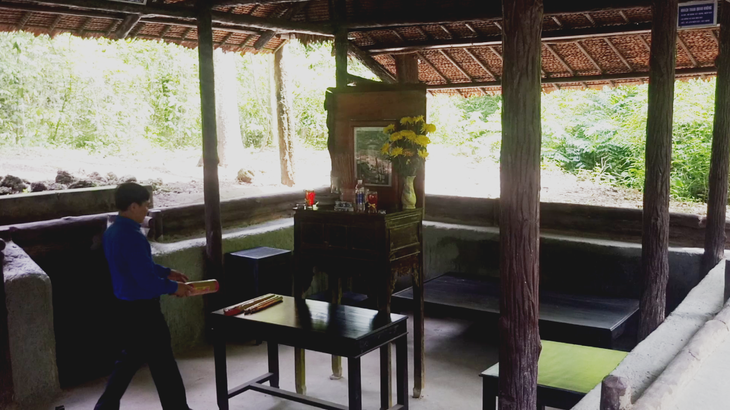 A cottage dedicated to Deputy Commander Nguyen Thi Dinh, the first female general of the Vietnam People's Army. (Photo: binhphuoc.gov.vn) A cottage dedicated to Deputy Commander Nguyen Thi Dinh, the first female general of the Vietnam People's Army. (Photo: binhphuoc.gov.vn) |
The rudimental cottages were made for Pham Hung, late Chairman of the Council of Ministers; Le Van Tuong, political commissar of Liberation Army of the South of Vietnam; and Deputy Commander Le Duc Anh, who later became Vietnam’s President; and Deputy Commander Nguyen Thi Dinh, the first female general of Vietnam People's Army. The meeting room and hall are a bit larger. Commander Tran Van Tra lived at the side of the forest.
“Inside the Ta Thiet relic site remains a village of ten families living together. Commander Tran Van Tra lived with them during the war. When he had spare time, he often tended fruit trees, planted vegetables, and fed the fish. The Khmer villagers are now taking care of a one-hundred-year-old mango tree right in front of his cottage. They used to call him ‘thum’, meaning ‘big father’. The way they addressed him showed that they were aware of Ta Thiet as the headquarters of the resistance war and secretly concealed the commander until the victory day,” tour guide Thuy elaborated.
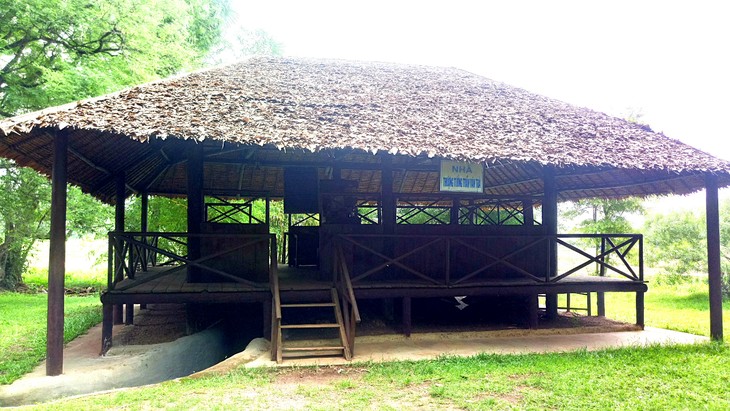 Commander Tran Van Tra's cottage in the Ta Thiet military base. (Photo: binhphuoc.gov.vn) Commander Tran Van Tra's cottage in the Ta Thiet military base. (Photo: binhphuoc.gov.vn) |
Leaving the cottages, tour guide Thuy led us to the kitchen of Ta Thiet-based soldiers and those marching through this area, where a system of less-smoke stoves are being preserved. The stoves were named after their inventor “Hoang Cam”, a northern soldier who took charge of logistics. His childhood memories from being a shepherd boy, who dug a pit to roast rats, inspired him to make the less-smoke stoves to avoid being detected by enemy airplanes. He tried and failed around 200 times before his success in 1951 during the Hoa Binh campaign against the French colonialists. The stoves served Vietnamese troops with hot, delicious meals during the Dien Bien Phu campaign, a glorious milestone in Vietnam’s struggle for independence in 1954, and throughout the resistance war against the Americans.
Tour guide Thuy told us about its operation, “The stove system was dug underground. The stoves were connected to several smoke outlets. Above the groove placed the branches and leaves and covered with a thin layer of water to keep the moisture. The smoke from the kitchen stove through the ditches was just a quick dissipation of steam when leaving the ground.
“Therefore, chefs could cook during the day, even when the enemy reconnaissance aircraft flew overhead, and avoided their advanced aerial detection of smoke. Inside Ta Thiet military base, you can easily see the laterite pieces, which are traces of Hoang Cam chimneys from war time. Hoang Cam stoves landed in the army’s principles with a slogan: ‘go without footprint, cook without smoke, and speak without voice.’”
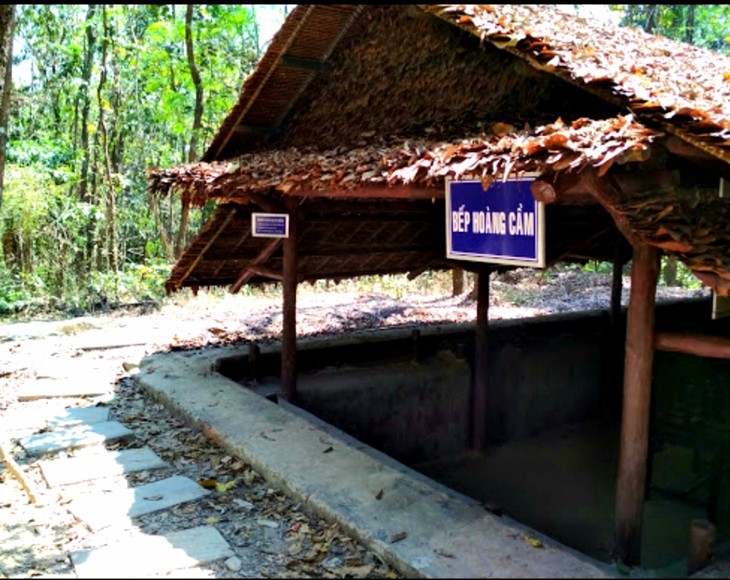 The kitchen of the Ta Thiet military base where Hoang Cam stoves were dug (Photo: binhphuoc.gov.vn) The kitchen of the Ta Thiet military base where Hoang Cam stoves were dug (Photo: binhphuoc.gov.vn) |
At the end of the trip, visitors offered incense to the fallen soldiers at a memorial house inside the Ta Thiet military base. Just half a day is enough to explore it. But it doesn’t matter if you want to stay overnight to enjoy the tranquility of what used to be a hectic base of Vietnamese troops.
Visitor Mai The Thao shared his feeling at the conclusion of his trip to Ta Thiet, “I myself am a former soldier serving in the Information Communications Command for ten years. I totally understand the wisdom of our leaders to coordinate all the military forces to achieve our victories. My heart goes to the leaders of the Vietnamese army, who were at the top position but lived in underprivileged circumstances in this military base. More than that, I’m really proud and adore them, for enduring such hardship all the way until reunification day.”